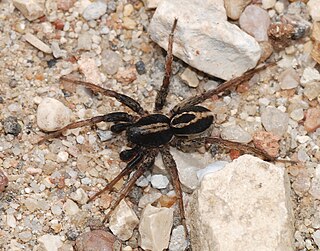
The sac spiders of the family Clubionidae have a very confusing taxonomic history. Once, this family was a large catch-all taxon for a disparate collection of spiders, similar only in that they had eight eyes arranged in two rows and conical anterior spinnerets that touched, and were wandering predators that built silken retreats, or sacs, usually on plant terminals, between leaves, under bark, or under rocks. These are now recognized to include several families, some of which are more closely related to the three-clawed spiders, like lynx and wolf spiders, than to Clubionidae and related families.

Zoropsidae, also known as false wolf spiders for their physical similarity to wolf spiders, is a family of cribellate araneomorph spiders first described by Philipp Bertkau in 1882. They can be distinguished from wolf spiders by their two rows of eyes that are more equal in size than those of Lycosidae.

Zoropsis spinimana is a spider species belonging to the family Zoropsidae.

The RTA clade is a clade of araneomorph spiders, united by the possession of a retrolateral tibial apophysis – a backward-facing projection on the tibia of the male pedipalp. The clade contains over 21,000 species, almost half the current total of about 46,000 known species of spider. Most of the members of the clade are wanderers and do not build webs. Despite making up approximately half of all modern spider diversity, there are no unambiguous records of the group from the Mesozoic and molecular clock evidence suggests that the group began to diversify during the Late Cretaceous.
Zorodictyna is a genus of spiders in the family Udubidae native to Madagascar. It has been described as an intermediate genus between Zoropsidae and Dictynidae, though it is now placed in Udubidae. This genus was originally placed in the family Zoropsidae, but it has been reassigned several times since. In 1967, Lehtinen moved it to Miturgidae. In 1999, it was moved back to Zoropsidae, and in 2015, it was moved to Udubidae.
Campostichomma is a genus of spiders in the family Udubidae native to Sri Lanka. Many of its species were moved to either Griswoldia or Devendra. This genus was originally placed in the family Agelenidae. It was moved to Miturgidae in 1967, to Zoropsidae in 1999, then to Udubidae in 2015.
Argistes seriatus, is a species of spider of the genus Argistes. It is endemic to Sri Lanka.
Devendra pardalis is a species of spider of the family Zoropsidae. It is endemic to Sri Lanka.
Devendra is a genus of Asian false wolf spiders first described by Pekka T. Lehtinen in 1967. The genus is endemic to Sri Lanka.
Devendra pumilus, is a species of spider of the family Zoropsidae. It is endemic to Sri Lanka.
Lauricius is a genus of North American false wolf spiders that was first described by Eugène Louis Simon in 1888. As of September 2019 it contains two species, found in the United States and Mexico: L. hemicloeinus and L. hooki. Originally placed with the sac spiders, it was transferred to the Zoropsidae in 1967.
Hoedillus is a genus of spiders in the family Zoropsidae. It was first described in 1898 by Simon. As of 2017, it contains only one species, Hoedillus sexpunctatus, found in Guatemala and Nicaragua.
Akamasia is a genus of spiders in the family Zoropsidae. It was first described in 2002 by Bosselaers. As of 2017, it contains only one species, Akamasia cyprogenia, found in Cyprus.
Cauquenia is a genus of spiders in the family Zoropsidae. It was first described in 2013 by Piacentini, Ramírez & Silva. As of 2017, it contains only one species, Cauquenia maule, found in Chile.
Krukt is a genus of spiders in the family Zoropsidae. It was first described in 2005 by Raven & Stumkat. As of 2017, it contains 5 species, all found in Queensland.
Megateg is a genus of spiders in the family Zoropsidae. It was first described in 2005 by Raven & Stumkat. As of 2017, it contains 8 species, all from Queensland.
Phanotea is a genus of spiders in the family Zoropsidae. It was first described in 1896 by Simon. As of 2017, it contains 13 species, all from South Africa.
Pseudoctenus is a genus of spiders in the family Zoropsidae. It was first described in 1949 by Caporiacco. As of 2017, it contains 2 species.
Takeoa is a genus of spiders in the family Zoropsidae. It was first described in 1967 by Lehtinen. As of 2017, it contains 2 species, both found in Asia.



